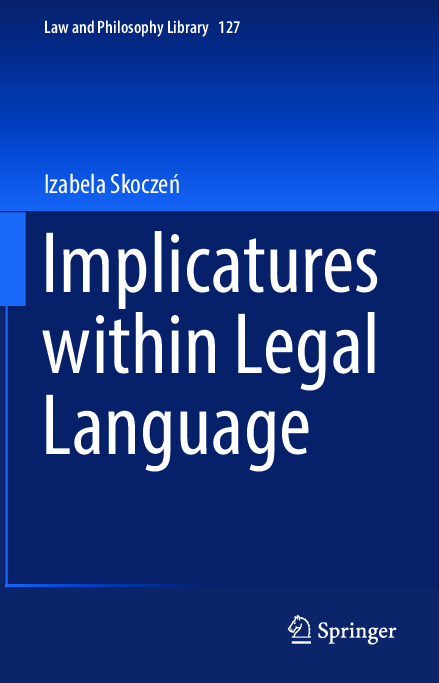File #2701: "2019_Book_ImplicaturesWithinLegalLanguag.pdf"
Testo
1|Acknowledgments|6
1|Contents|7
1|Chapter 1: Introduction|10
2|1.1 A Roadmap|10
2|1.2 Hart and Dworkin on Communication in Law|13
2|1.3 The History of Linguistic Pragmatics|15
2|1.4 Some Remarks Concerning Current Interdisciplinary Approaches to Philosophy of Language, Law and Mind|20
2|References|23
1|Chapter 2: The Strategic Principle and the Maxim of Selectivity|24
2|2.1 Outline of the Classical Gricean Project|24
2|2.2 The Cooperative Principle and the Maxims|25
2|2.3 Conversational vs. Conventional Implicatures|28
2|2.4 Intention|30
2|2.5 Generalized and Particularized Conversational Implicatures|34
2|2.6 Some Features of Conversational Implicatures|35
2|2.7 Applying the Classical Gricean Project to the Legal Realm|36
3|2.7.1 The Cooperative Principle in Law|38
3|2.7.2 Strategic Speech|38
3|2.7.3 The Strategic Super-Maxim of Selectivity|43
3|2.7.4 The Clash of the Maxims|59
3|2.7.5 The Strength of Implicature|59
3|2.7.6 Why ‘What Is Said’ Is Not Always Said?|60
2|References|62
1|Chapter 3: Post-Gricean Implicature Theories and Their Relevance for the Legal Realm|64
2|3.1 Relevance Theory|65
2|3.2 Relevance Theory and the Legal Discourse|70
3|3.2.1 The Amendments to the Classical Gricean Picture|70
3|3.2.2 Why RT Cannot Be a Sufficient Theory of Legal Pragmatics|74
2|3.3 The Q and R Principles|79
2|3.4 The Q and R Principles in Legal Discourse|83
2|3.5 Q and I Heuristics|88
2|3.6 The Canons of Construction|91
2|3.7 Conclusion|96
2|References|96
1|Chapter 4: Propositionalism and the Law|98
2|4.1 The Completeness of Legal Propositions|98
3|4.1.1 Why Is ‘What Is Said’ Not Said?|99
2|4.2 What Can a Theorist of Legal Language Learn from the ‘Border Wars’?|109
3|4.2.1 The Separation of Powers Principle|109
3|4.2.2 The Consequences of Choosing a Stance in the Debate on Propositionalism for the Separation of Powers Principle|112
2|4.3 Some Famous Examples of Pragmatic Enrichment in the Law|117
2|4.4 Baum-Levenbook’s Set of Ordered Norms|121
2|4.5 Conclusion: Strategic Speech and Pragmatic Enrichment|124
2|References|127
1|Chapter 5: The Meaning of Law|129
2|5.1 Intention in Natural Language|130
3|5.1.1 The Reductive Program of the Internalist|131
3|5.1.2 The Program of the Externalist|134
2|5.2 Meaning Versus Pragmatics: Some Terminological Clarifications|135
2|5.3 The Gricean Theory of Meaning|144
2|5.4 More Internal Projects|145
2|5.5 More External Projects|147
2|5.6 A Theory of Meaning for Legal Discourse|149
3|5.6.1 Grice on the Meaning of Law|149
3|5.6.2 The Meaning of Legal Texts Is External|152
3|5.6.3 Institutional Intentions Are Not Reducible to Collective Intentionality|156
3|5.6.4 The Functionalist Account of Institutional Intentions|160
3|5.6.5 Externalism in Disguise|161
2|5.7 Conclusion|165
2|References|167
1|Chapter 6: The Exchange Between Legislature and Courts: Examples of Strategic Behavior from the Polish Legal System|169
2|6.1 Introduction|169
2|6.2 Criminal Law|170
2|6.3 Civil Law|175
3|6.3.1 Incapacitation|175
3|6.3.2 Oral Wills|177
2|6.4 Conclusions|177
2|References|178
1|Chapter 7: General Conclusions|179
1|Contents|7
1|Chapter 1: Introduction|10
2|1.1 A Roadmap|10
2|1.2 Hart and Dworkin on Communication in Law|13
2|1.3 The History of Linguistic Pragmatics|15
2|1.4 Some Remarks Concerning Current Interdisciplinary Approaches to Philosophy of Language, Law and Mind|20
2|References|23
1|Chapter 2: The Strategic Principle and the Maxim of Selectivity|24
2|2.1 Outline of the Classical Gricean Project|24
2|2.2 The Cooperative Principle and the Maxims|25
2|2.3 Conversational vs. Conventional Implicatures|28
2|2.4 Intention|30
2|2.5 Generalized and Particularized Conversational Implicatures|34
2|2.6 Some Features of Conversational Implicatures|35
2|2.7 Applying the Classical Gricean Project to the Legal Realm|36
3|2.7.1 The Cooperative Principle in Law|38
3|2.7.2 Strategic Speech|38
3|2.7.3 The Strategic Super-Maxim of Selectivity|43
3|2.7.4 The Clash of the Maxims|59
3|2.7.5 The Strength of Implicature|59
3|2.7.6 Why ‘What Is Said’ Is Not Always Said?|60
2|References|62
1|Chapter 3: Post-Gricean Implicature Theories and Their Relevance for the Legal Realm|64
2|3.1 Relevance Theory|65
2|3.2 Relevance Theory and the Legal Discourse|70
3|3.2.1 The Amendments to the Classical Gricean Picture|70
3|3.2.2 Why RT Cannot Be a Sufficient Theory of Legal Pragmatics|74
2|3.3 The Q and R Principles|79
2|3.4 The Q and R Principles in Legal Discourse|83
2|3.5 Q and I Heuristics|88
2|3.6 The Canons of Construction|91
2|3.7 Conclusion|96
2|References|96
1|Chapter 4: Propositionalism and the Law|98
2|4.1 The Completeness of Legal Propositions|98
3|4.1.1 Why Is ‘What Is Said’ Not Said?|99
2|4.2 What Can a Theorist of Legal Language Learn from the ‘Border Wars’?|109
3|4.2.1 The Separation of Powers Principle|109
3|4.2.2 The Consequences of Choosing a Stance in the Debate on Propositionalism for the Separation of Powers Principle|112
2|4.3 Some Famous Examples of Pragmatic Enrichment in the Law|117
2|4.4 Baum-Levenbook’s Set of Ordered Norms|121
2|4.5 Conclusion: Strategic Speech and Pragmatic Enrichment|124
2|References|127
1|Chapter 5: The Meaning of Law|129
2|5.1 Intention in Natural Language|130
3|5.1.1 The Reductive Program of the Internalist|131
3|5.1.2 The Program of the Externalist|134
2|5.2 Meaning Versus Pragmatics: Some Terminological Clarifications|135
2|5.3 The Gricean Theory of Meaning|144
2|5.4 More Internal Projects|145
2|5.5 More External Projects|147
2|5.6 A Theory of Meaning for Legal Discourse|149
3|5.6.1 Grice on the Meaning of Law|149
3|5.6.2 The Meaning of Legal Texts Is External|152
3|5.6.3 Institutional Intentions Are Not Reducible to Collective Intentionality|156
3|5.6.4 The Functionalist Account of Institutional Intentions|160
3|5.6.5 Externalism in Disguise|161
2|5.7 Conclusion|165
2|References|167
1|Chapter 6: The Exchange Between Legislature and Courts: Examples of Strategic Behavior from the Polish Legal System|169
2|6.1 Introduction|169
2|6.2 Criminal Law|170
2|6.3 Civil Law|175
3|6.3.1 Incapacitation|175
3|6.3.2 Oral Wills|177
2|6.4 Conclusions|177
2|References|178
1|Chapter 7: General Conclusions|179

